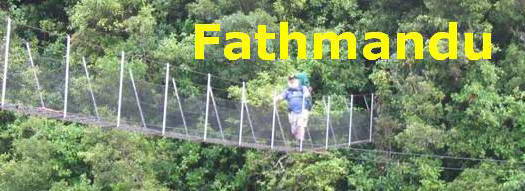
Many thanks for permission to use graphics from their software and toposheets |
 |
|
Not your ordinary backpackers part 2One of the features of the downhill trip is a small-leaved Coprosma I haven't seen before, C. parviflora, whose principal feature is that its branchlets grow in a flat plane. Given their quite striking grey green quality and these flat layers of leaves and branches they really stand out.
There are a number of these small-leaved coprosma species in our local Woodhill Forest that I still haven't nailed to my satisfaction. Given also their tendency to hybridise quite readily, one might hand them all a collective title of Coprosma promiscuus. Also growing in this district and nowhere else until Tony's seed sales take off, is Coprosma whangaroa, another small-leaved species. Occasional views out through gaps in the bush show great jutting outcrops of rock.
This formation is absolutely typical of the Whangaroa area. There are stories of local Maori, many, many, years ago,taking prisoners to the top of cliffs like these and giving them the option of jumping off or being pushed. Tony takes us out near the edge of such an outcrop to examine the variety of plantlife that has gained a foothold on this apparently barren rock, but after paying $4 for a tap lager last night, I do not completely trust the locals, and stay a few metres back. One of the features of this part of the walk is the filmy fern, its translucent leaves one cell thick. These are mostly dry and shrivelled at present, but at the first sign of moisture they perk up immediately. Also along this part of the walk is the world's tallest moss, Dawsonia superba.
Lacebark (Hoheria populnea) or Houhere is also present along the track. This is such a well-established garden tree that one tends to overlook it in the wild. It is not, however a feature of our local forest.
Here and there are reminders that not every farm succeeded. This track we are on was originally used for the horse drawn transport of milk from farms in the valley. It's also an indication of how quickly bush can regenerate.
Despite fairly heavy logging in the area, there are still a number of fairly big trees along the way, and Tony stops us beside one of these. Growing on the trunk is a tiny plant called Tmesipteris, one of the group known as fork ferns. (In case you were wondering, the initial t is silent.) It is one of the oldest life forms still in existence.
We emerge at the bottom of the track hard up against the stream, and a couple of relatively dry stream crossings later, it's time for lunch. Tony travels light
but we are in training and are carrying heavier packs. For all that, I have left our mugs in the car after lunch yesterday, and we make do with our water bottles. Always use a list....
|
|